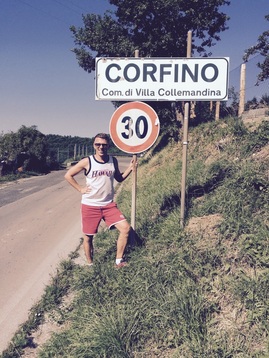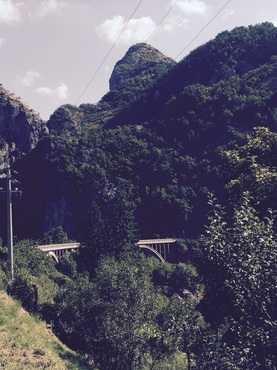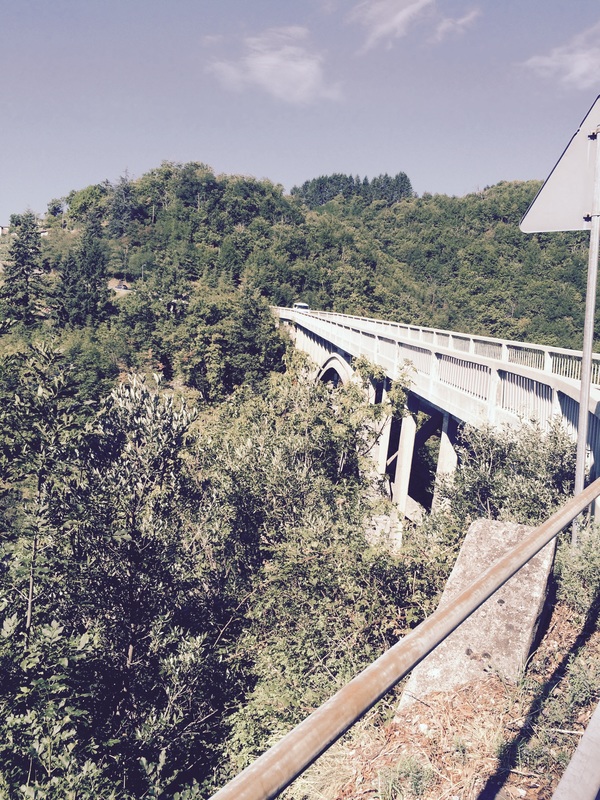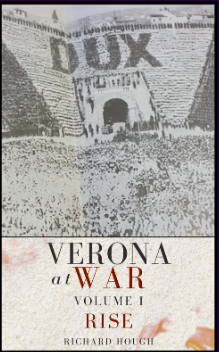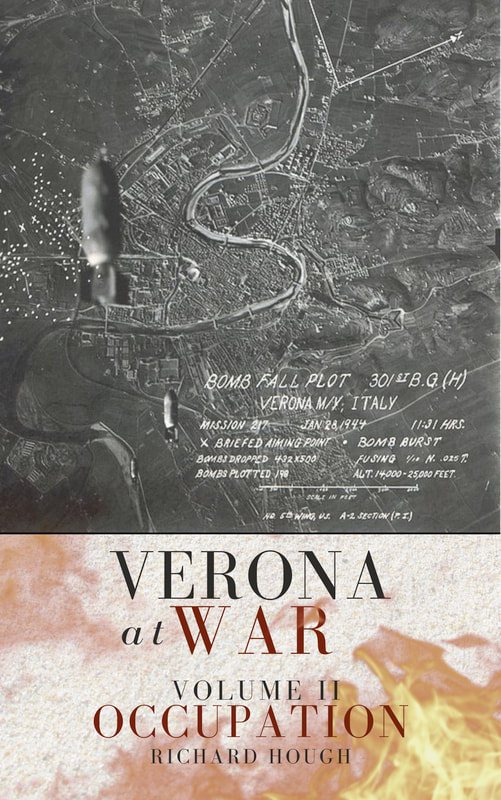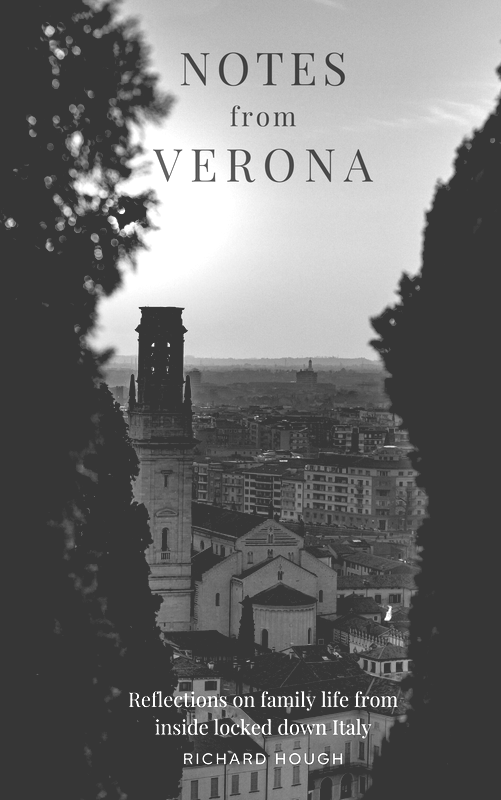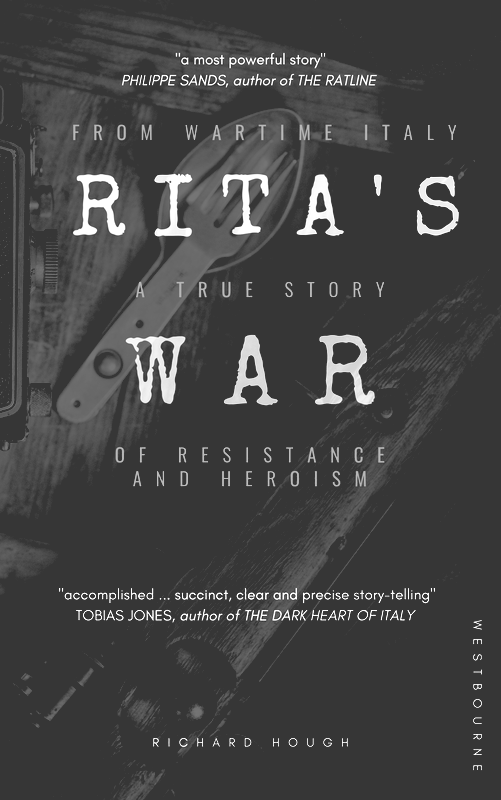|
For us, the bridge represents the final dramatic landmark on what has often been a long and tiring journey. From this point there are only two more hairpin bends and a tight right hand turn before we arrive in Corfino itself, where (no matter what the hour) a warm-welcome, a hearty meal and a bottle of rustic tuscan wine await.
It is only in the last couple of years that I have become aware of the bridge’s more proper name - “Ponte Attilio Vergai” and it was only on my most recent trip to Corfino, while taking an invigorating morning run across the bridge, that I asked myself ‘who is/was Attilio Vergai?’ Vergai's story, played out in these hills, is a little known story of of drama, tragedy and mystery.
For nearly 20 years now, I’ve been coming to Corfino, a small village high in the north Tuscan region of Garfagnana. Accessible only by narrow, winding mountain roads, driving here is not for the faint-hearted!
At over 800 metres above sea level, the most dramatic moment of the journey to Corfino is surely crossing the Ponte di Corfino. Constructed in 1935 with the help of donations from Corfino’s diaspora, the Ponte di Corfino is in fact a double arched viaduct. In order to fully appreciate the complex geographical landscape it traverses, I’d recommend walking (or running) across the bridge, rather than simply driving straight over it. 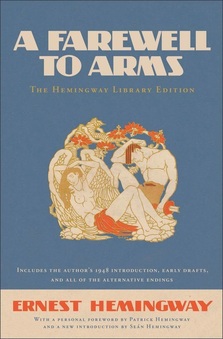 The Battle of Caporetto is the backdrop for Ernest Hemingway’s seminal novel A Farewell to Arms. The Battle of Caporetto is the backdrop for Ernest Hemingway’s seminal novel A Farewell to Arms.
Attilio Vergai was born in Corfino on 15 August 1895. He studied law but his studies were interrupted by the outbreak of the First World War. He serves as a cavalry lieutenant, but his wartime experience ends at the Battle of Caporetto, where the Italians are routed by Austro-Hungarian forces, reinforced by German units and large amounts of poison gas.
Vergai is one of 265,000 Italian’s taken prisoner by the Austrians. After the war, Vergai resumes his studies and graduates, entering the legal profession in the early 1920s. In 1924 he marries local girl Amelia Nelli and in subsequent years the couple have three sons: Francesco, Giovanni and Luciano. In 1927 he becomes mayor of Villa Collemandina and in this capacity he commits himself to a project that has been discussed locally for decades and which, after the devastating earthquake of 1920, is considered essential to the region’s infrastructure - the construction of a bridge that links the villages of Corfino and Canigiano with the administrative centre of Villa Collemandina. 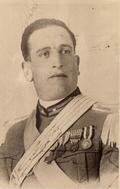
Having persuaded the Corfinese diaspora to contribute some 200 million lire (more than 200 thousand Euros today), the final design of the bridge was entrusted to the engineer Arturo Danusso, professor at Milan Polytechnic.
The viaduct - two arches of about 60 meters each and 87 meters high (the highest in Europe at the time) - was inaugurated on 7 July 1933. Two months later, Vergai relinquishes his mayoral duties and accepts the post of Director of the Castelnuovo branch of the Cassa di Risparmio di Lucca. For Italy, this is a time of aggressive, fanatical extremism, culminating on 10 June 1943 when, as Paris falls, Mussolini opportunistically declares war on Britain and France. Things do not proceed as planned for the fascist leader and in July 1943 an Allied invasion of Italy begins, leading to the collapse of the Fascist regime and, on 25 July, Mussolini's removal from office. On 8 September 1943, Italy surrenders. Worse is to come. Germany takes control of northern and central Italy and establishes the Italian Social Republic (also known as the Republic of Salò), a Nazi puppet state with Mussolini installed as its hapless leader. A large anti-fascist resistance movement emerges, as Italy descends into a bloody and desperate civil war, played out in the villages, towns and cities of the peninsula. 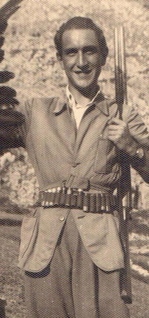
Following the armistice and establishment of the Salò Republic, Vergai makes contact with a group of high school students from Lucca coordinated by Professor Carlo Del Bianco, the first active partisans in Garfagnana. Vergai and his fellow partisans help hundreds of Allied prisoners of war who are on the run from POW camps.
In December 1943, in response to the enforced conscription of military-aged men, Vergai encourages local youngsters to take to the fields and join the partisan struggle. By the summer of 1944, the front line has reached Castelnuovo di Garfagnana (less than 15 kilometres from Corfino). Vergai is ordered by a group of Fascist Officers to hand over all his bank’s assets. After some discussion, Vergai rejects the request. The fascists leave, threatening to blow up the safe. Late that night Vergai defies the curfew, bombings and enemy patrols, and removes all remaining assets, documents, books and checks and delivers everything to a guide who crosses the front line to Lucca where they are safely deposited. A few days later the now empty safe is blown up by a group of fascists. In January 1945, following a clash in Corfino, two soldiers of the fascist San Marco Brigade are captured by the partisans. The next day, an entire enemy battalion surrounds the village and prepares to destroy it. In an unlikely but welcome coincidence, the commander of the Fascist brigade and Vergai are former comrades, having fought alongside each other during the Great War. In return for the guaranteed safety of the village, Vergai agrees to release the prisoners and hand over 1000 pairs of wool socks. The women of the village work all night to prepare the socks and the fascists withdraw. Vergai’s resistance activity, though, does not escape the attention of the local fascist authorities.
At Fivizzano the fascists find an entire archive that documents the activities of the local partisan division and, on 27 February 1945, a contingent of local fascist troops again encircle the village. Officers appear at Vergai’s house and arrest him on charges of espionage and aiding the desertion of Italian soldiers.
Transferred to a military prison in Camporgiano, he is subjected to prolonged interrogation. On 14 March 1945, exhausted and with a high fever, he is again interrogated and eventually provides the following declaration: "I regret what I did and I declare that from now on I will work with the Social Republic."
They ask him to sign it in exchange for his release. He refuses. The next morning Vergai’s inmates realize that he has disappeared. His remains have never been found, nor anything or anyone that indicates with any certainty how he died. 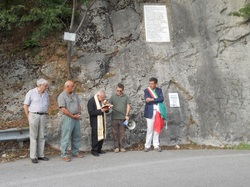
One theory is that he died at sea, the victim of an Allied bombing raid while being transferred from the prison of La Spezia to Genoa. Another heroic victim of Italy's tragic past.
On the evening of 5 August 2015, an event was held in Corfino to mark the publication of a new book “Storie di guerra e di resistenza”. Vergai’s grandchildren, relatives and many inhabitants of the village attended. That afternoon, a new plaque was unveiled in memory of Atillio Vergai at the bridge that bears his name.
As our holiday draws to a close, we cross the bridge once more, and head for the mountain pass that takes us back to Verona.
|
AboutRichard Hough writes about history, football, wine, whisky, culture + travel and is currently working on a trilogy about wartime Verona.
|
